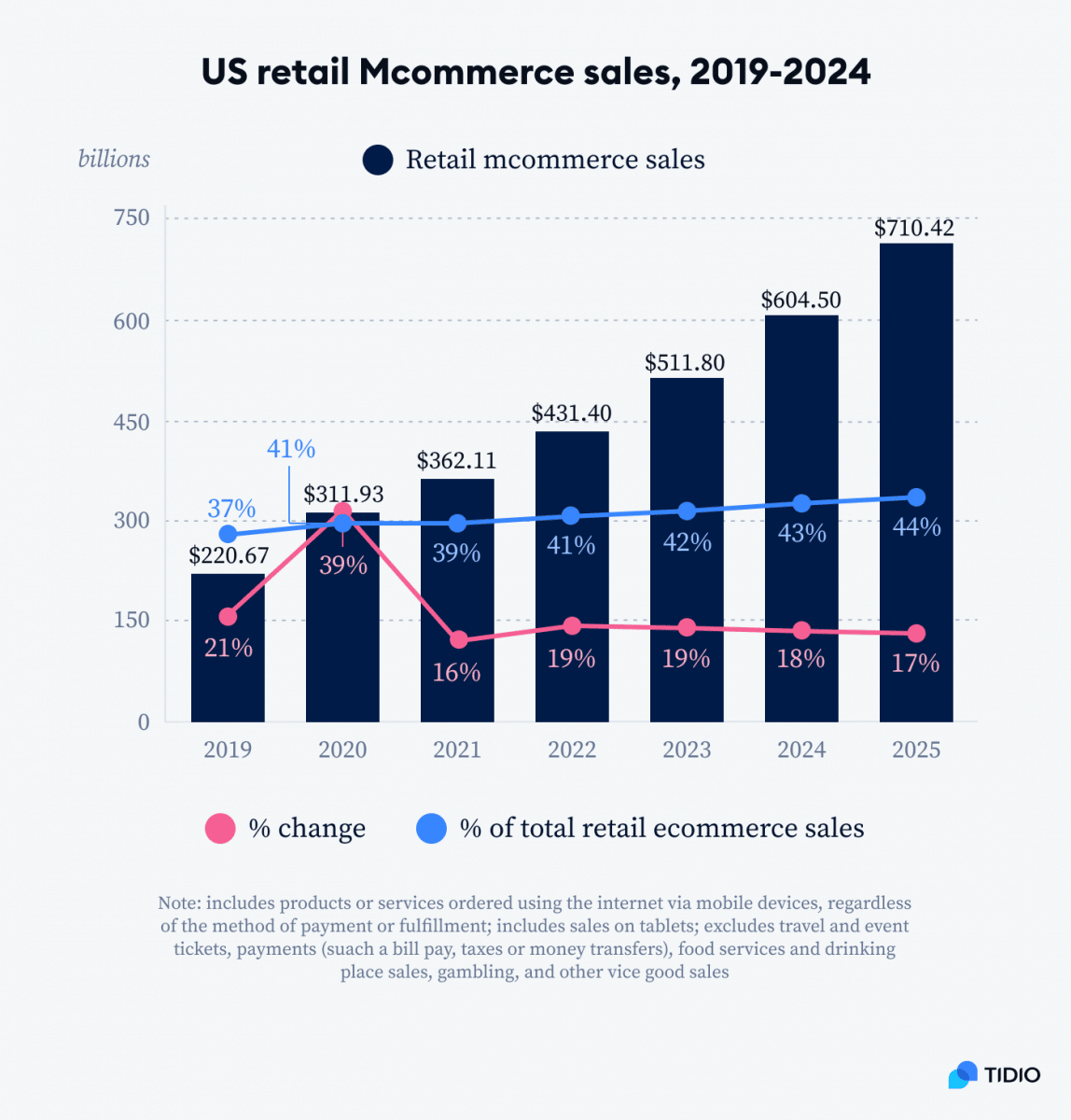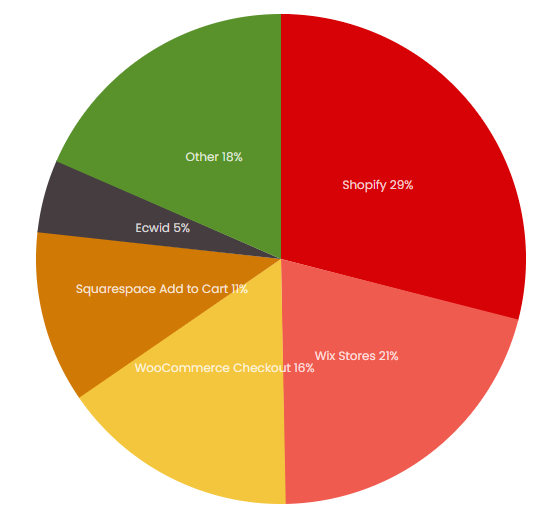My content is reader-supported by awesome people like you. Which means I could earn a commission. Learn more here!
When you think about e-commerce, you probably picture a online store that is constantly promoting new deals, products, services, and so forth.
eCommerce involves a lot more strategy from a marketer’s point of view.
Even though some marketers are looking towards other markets for big gains, the eCommerce market has tons of potential.
Internet businesses are easy to start and still booming according to these facts and statistics.
While it’s still a relatively new technology and form of sales, eCommerce can provide you with a steady amount of income, and if you are a small or major retailer with a physical location, you can improve your sales growth just by adding this online element to your sales funnel.
The following 40 facts will make you not only want to improve your eCommerce store but also provide inspiration for a variety of other outlets for online income.
Most consumers prefer to shop online for a variety of reasons.
Some of these include:
- Time-saving
- Fewer taxes
- Easy to compare prices
- No crowds
- More Variety
In addition, many shoppers prefer to research products online first and get an idea of the price before they go to a physical location.
If fast and free shipping is offered, many shoppers would rather purchase online than go in-store for items that don’t require you to see the merchandise firsthand.
However, shoppers are less likely to jump on deals for items online that require more research in person.
For example, shoppers may go in-store to look at shoes, but they may still buy online if they find a better deal while browsing their phones in-store.
Some Quick Facts
| eCommerce Fact |
|---|
| Global eCommerce sales are projected to hit $9.66 trillion by 2026. |
| There are over 26.5 million eCommerce websites worldwide. |
| Mobile commerce is expected to generate $728 billion in sales by 2025. |
| Shopify now powers over 4.58 million online stores globally. |
| Around 70% of shopping carts are abandoned before purchase. |
| 75% of online shoppers expect free shipping when ordering products. |
| 46% of consumers rely on social media to help with purchasing decisions. |
| A 1-second delay in website loading can decrease conversions by up to 7%. |
| By 2040, it’s estimated that 95% of all purchases will happen online. |
| 80% of shoppers prefer buying from brands that offer personalized experiences. |
| Voice commerce sales are expected to reach $19.4 billion by 2025. |
eCommerce Usage Distribution on the Entire Internet
Mobile eCommerce Facts

As the following statistics will show you, mobile e-commerce is very important to retailers who decide to provide online stores.
If you don’t have a store that is accessible through a phone or that is optimized for a mobile device, you will have a much harder time getting people to purchase items from your store especially if it is an item that they can find from another retailer.
Mobile-optimized online stores feature quick and easy checkouts, one tap navigator, bigger images, and intuitive interfaces that respond to touch scrolling.
By creating an online store that can be accessed from a tablet or smartphone, you likely reach thousands of new customers each month.
Key Mobile Data & Statistics
By 2025 mobile eCommerce global sales will reach $728.28 Billion
mCommerce sales are projected to exceed $510 billion in 2023 and $710 billion in 2025
By 2024, there will most likely be over 187 million active mobile shoppers in the US alone
49% of mobile users compare the pricing of products or services on their smartphones
The conversion rate for shoppers is still higher at 3% than on mobile at 2%
Amazon is the leading mobile app that is downloaded, followed by SHEIN
Let’s Start with the Basic eCommerce Facts
eCommerce actually started in 1979. Michael Aldrich connected a domestic television set with a phone line to create online shopping back, which boomed in the 1980s and 1990s before the Internet took off.
Amazon launched in 1995. However, Amazon didn’t start turning a profit until 2003. The average order value as of 2012 for Amazon is $47.31, and of course, Amazon is known as one of the largest online retailers.
Netflix was not the first online DVD subscription retailer. Blockbuster created Blockbuster.com in 2004, but it’s not clear when the service began that was like Netflix. Ultimately, Redbox and Netflix led to the downfall of what used to be the biggest name in home video entertainment.
As of the third quarter in 2012, $4,423 in transactions occurred through Paypal per second. Paypal has expanded in recent years becoming the most well-known way to pay online without having to give up your credit card information.
Groupon turned down a deal from Google for $6 billion in 2010. The online deal broker became an IPO the next year.
How Social Media Affects eCommerce
1. Zappos makes money off of referrals from social media. The online retailer takes $0.75 from Pinterest, $2.08 from Facebook, and $33.66 from Twitter.
2. 46 percent of online shoppers count social media when deciding whether to buy something online.
3. 47 percent of shoppers say that Facebook has the greatest impact on what they buy.
4. 54 percent of Facebook members use their phones to browse. There’s no doubt that mobile e-commerce has grown rapidly and continues to bring in billions of dollars for retailers who have mobile-accessible online stores.
5. Polyvore has the largest average order value maintaining $66.75 per order.
6. Posts with photos get 53% more Likes, 104% more comments, and 84% higher click-through rates.
7. The average order value for customers referred from Instagram is $65.00, followed by Facebook ($55), Twitter ($46), and YouTube ($38).
Facts on eCommerce Growth
1. More than 80 percent of the online population has used the Internet to purchase goods and services.
2. 50 percent of the population online has shopped at Internet retailers more than one time.
3. By the year 2040, it’s estimated that 95% of all purchases will be through eCommerce.
4. The highest-growing country for e-commerce is India followed by Saudi Arabia, Indonesia, Australia, and the Philippines. The least growth for online shopping includes Latvia, Ukraine, and France.
5. According to eMarketer estimates, retail e-commerce sales reached $2.3 trillion in 2017, a 23.2 percent increase over the previous year
Some Other Statistics About eCommerce
From the above it’s clear to see that connecting mobile and social media together with e-commerce is essential for prominence and growth with any online retailer.
However, you can learn a lot from the following statistics as well including what are the biggest e-commerce stores, what age groups love shopping online, and what types of payment make it easiest for customers to purchase online.
Most online shoppers use bank transfers or credit cards to pay. In fact, 40 percent of online purchases are made by credit card. However, Paypal is quickly growing at 35 percent.
North Dakota shoppers spend the most money online. Typically, this state’s residents spend 16.17 percent of their income on online purchases.
The biggest e-commerce store now is Amazon. Second is eBay, followed by Apple, Walmart, and Home Depot.
Online shoppers in the 31 to 44 and 55 to 65 age groups spend the most money shopping online at 68 percent.
Online shoppers spend between $1,200 and $1,300 on purchases made over the Internet each year.
Pizza Hut was the first pizza chain to offer online ordering in 1994.
Most shoppers at 71 percent believe that they can find a better deal when they shop online rather than going to a store.
It’s expected that the number of online consumers will grow to 201 million by 2015.
As of right now, there are 195 million online consumers buying things every minute through e-commerce stores.
eCommerce Facts About Shopify
Let’s look at some eCommerce facts about the top eCommerce platform, Shopify.
1. Over 1.75 million businesses globally are utilizing Shopify
2. In 2022, Shopify merchants will have over 500 million buyers.
3. In 2021 Shopify processed over 79 billion in order values
4. The United States accounts for 50% of the total Shopify merchants
5. In 2020 458 million shoppers make a purchase from a Shopify store
6. The most popular category to sell is fashion
Predictions for E-Commerce in 2024 and Beyond
Most of these statistics point to the fact that e-commerce is already the best way for businesses to expand their inventory and sales growth.
In the next decade, it’s likely that shopping online will increase dramatically to the point that most purchases are made online even for items that may have required “to be seen” first.
This is due to new technology, faster checkout, and easily compared prices of goods. However, more people are also concerned about the lack of security for online shopping.
With several breaches in online security for major retailers like Target, Home Depot, and Neiman Marcus, people are looking for safer ways to pay online that don’t require them to provide a credit card number directly.
The next steps for e-commerce must evolve around safe, fast, and mobile shopping.
If retailers can ensure that their shoppers have the most pleasant experience by shopping online, there’s no reason for shoppers to go in-store.
Sources To Check Out
- https://blog.paymill.com/social-media-ecommerce/
- https://www.factbrowser.com/tags/ecommerce/
- https://mashable.com/2012/11/06/ecommerce-statistics/
- https://getlevelten.com/blog/julie-miller/10-shocking-e-commerce-facts
- Internet Retailer
- https://neilpatel.com/blog/more-likes-on-facebook/
- https://www.shopify.com/
- eMarketer Insider Intelligence
- Kibo Commerce
- Statista
So, do any of these stats stand out to you? Or possibly see any stats that really stand out? For me, it was the fact that “$4,423 in transactions occurred through Paypal per second”. Pretty crazy to hear that.
Image Credit: Lending Memo
Written And Published By Christopher Pontine
When did eCommerce start?
Michael Aldrich connected a domestic television set with a phone line to create online shopping back, which boomed in the 1980s and 1990s before the Internet took off.
How many transactions occurred through Paypal per second?
As of the third quarter in 2012, $4,423 in transactions occurred through Paypal per second. Paypal has expanded in recent years becoming the most well-known way to pay online without having to give up your credit card information.






the meta title mentions 2021, and yet you haven’t updated fact number 13 which still shows the figure 6 years old. (of 2015)
Hi Mohit,
Thanks for catching that.
I’ll have to get that one updated 🙂
Thanks,
Chris